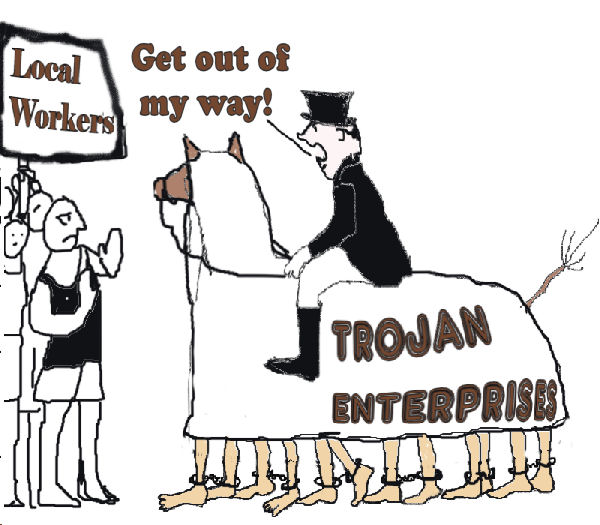Orwellian Waterworks: big-agribusiness and Victorian Gov
It looks like a corporate-agribusiness group called the "Foodbowl Group" have tapped a short-circuit in local, regional and state democracy in an attempt to take over land and water in the Murray Darling Basin. (See end this article for who the Foodbowl Group are).
Plans are for a $600 million pipeline to be paid for by Melbourne Water users who've been told to expect their bills to double over the next five years. They'll also pay nearly a third of the billion dollars allocated to carry 75 billion litres of water a year from the Goulburn Murray River system over the Great Dividing Range to Melbourne.
What is going on?
The Foodbowl group describes its aims as "To support the transition of small farming enterprises to world-competitive, sustainable agribusiness enterprises with a variety of models that maintain and enhance community cohesion." (More 'aims' lower down in article).
But were they invited? Were they asked?
Apparently not.
The impacted community, seems to be appalled and powerless. In the cities, in the rest of Australia, we all need to be paying attention to this. The Murray Darling Basin is Australia's only major inland food production area, and our richest. Despite horrendous farming practices, beginning with returned soldiers' plots, it still produces. Taking over this area with faceless big-business is not the answer to our environmental problems because big agribusiness answers to no-one and beats the life out of land and water before moving on. It is solely profit motivated, seeking to compete on the world market in a zero-sum game that takes no prisoners. The people who work in corporations may have good motives, but they are part of a machine which prioritises profit over anything else in a world where competition has taken over commonsense and sensitivity.
With fuel, food and water prices, cost of land and housing going up, Australians cannot rely on government to protect them. We have to avoid being split up and disempowered by so-called planning initiatives and top-down redesign of the way we live and produce food. When the chips are down it is only by ensuring that we have local production that we can negotiate for food and water, work and housing.
In the end, no government should tell people that they may not farm simply because they do not compete on the world market. Only two generations ago it was quite reasonable to aim for self-sufficiency, and not too much more was required to make a small income. These days, unless we ruin the land to make a dollar, we are priced off the land by taxes and regulations.
The world market is antithetical to sustainable agriculture - notably permaculture. Permaculture is the only sustainable way for Australian agriculture to survive. I don't pretend that you can have mixed farming everywhere; desert and rangeland comprise 75% of Australia. You cannot grow crops on rangeland; you can only run livestock, or live by hunting and gathering. The Victorian Government, like the other state governments and the Federal Government, have unreasonable commercial expectations, display little empathy for citizens, contempt for democracy, and a kind of worship for big business and development, called fascism elsewhere.
Barry Jones in his Sleepers Wake said it would come to this: governments overwhelmed by technology, taking advice from big business.
At the end of this article the investors in the Foodbowl group are listed. Here are the Foodbowl Group's objectives, as mentioned on their website
[Foodbowl Unlimited] Regional Development Objectives
"While funding for Stage 1 of the Irrigation Modernization Project has been provided under the State Water Plan, the Foodbowl Group believes a range of regional development initiatives must be taken in parallel with the project.
Strategies need to be developed on a whole of region basis to:
• Ensure local government and planning authorities are working together to co-ordinate land-use and planning policies to encourage development of the most suitable land for appropriate agriculture;
• Develop a continuing and informed dialogue with the agribusiness community regarding likely demand for crops and foodstuffs in the context of changing world demographics and climate change;
• To work with state and federal governments to attract large water-use industry to the region;
• To work with educational institutions to develop expertise in irrigation and water-use research and support appropriate skills development to meet the region’s emerging needs;
• To promote and encourage appropriate non-water infrastructure to support the region’s development as an increasingly important centre for food and processed food exporting;
• To support the transition of small farming enterprises to world-competitive, sustainable agribusiness enterprises with a variety of models that maintain and enhance community cohesion."
Who are the Foodbowl Group?
The Victorian Government is sponsoring this project in company with:
- Telstra
- Tyco Water Pty Ltd, Tyco Water Pty Ltd
37 Silica St, Carole Park 4300, Queensland, Australia.
Main business activities: Steel water pipes & fittings, steel pilings for wharfs & offshore structures.
Do they have anything to do with Mr Pratt and his Visy pvc piping projects in which the Victorian and Federal government became so involved? We don't know. Do you?
- GHD is an international engineering company: www.ghd.com.au/aptrixpublishing.nsf/Content/Directors_about
www.ghd.com.au/aptrixpublishing.nsf/Content/Offices_about
- Rubicon Systems Australia is a telecommunications, information technology and water technology company. Their Chairman, Stan Wallis, has long associations with multinational corporation management, and was formerly Chair of Amcor, AMP and Coles Myer, and author of the Wallis Report (Federal Government commissioned 1997). He is the President of the Business Council of Australia, which has been a major driver for the undemocratic push for a huge population in Australia. It is this push for population growth which has made recent droughts so much more severe and caused such great hardship. The Victorian Government, beginning with Jeff Kennett, spear-headed population growthism, at the behest of the Housing Industry and its upstream and downstream beneficiaries - mining, big-engineering, big-finance, newspaper-realty, and chipboard manufacture, among others.
See also, Who's who in AMCOR"
- The Hugh Williamson Foundation.
Under 'Governance', the Foundation lists Members of its 'Council' in 2007 as:
Richard Bluck AM, RFD, Executive Director, Leadership Victoria
John Allen, Principal, John Allen & Associates
Rhonda Barro (WCLP '99), Executive Director, Barro Group
Stella Clark, Stella Clark (WCLP '97), CEO, Bio 21 Aust. Ltd.
Geoff Cosgriff (WCLP '90), Executive Director, LogicaCMG P/L
Graham Evans AO, Consultant & former senior executive, BHP Billiton
Suzanne Jessup (WCLP '00). General Manager, Mahlab Recruitment
Charles Macek, Chairman, Sustainable Investment Research Institute
Andrea Polmear, Managing Director, Launching Pad
Garry Ringwood, Exec. Director, Executive Interim Management
Jane Tongs (WCLP '93), Chairman, Australian Alpine Enterprises
Jill Hollingworth (WCLP '97), Director, Tango Public Relations
What you can do: visit plugthepipe.com and join their mailing list.
Country Womens Association (CWA) Reject the North South Pipeline
2 June 2008
The CWA passed unanimously a motion at their annual conference over the weekend requesting that the Brumby government to stop the pipeline. Over 1000 women present.
Wording was as follows:
"that the CWA urge the Victorian Government not to proceed with the North-South pipeline which transfers water to Melbourne."
Contact: Doreen Napier, Agriculture and Environment Convenor, CWA - Phone 03 58522597

 In France at the moment there are national strikes over government proposals to make people work for 41 years instead of 40 years in order to obtain full pensions. In 2015 there will be around 14m workers to 18m retirees, according to demographic trends.
In France at the moment there are national strikes over government proposals to make people work for 41 years instead of 40 years in order to obtain full pensions. In 2015 there will be around 14m workers to 18m retirees, according to demographic trends.
 Being half-Icelandic in background I'd like to believe in intrinsic Norse wisdom but …
Being half-Icelandic in background I'd like to believe in intrinsic Norse wisdom but …  Tim Murray, 27 Dec 2007
Tim Murray, 27 Dec 2007

 (Photo by Narelle Smith)
(Photo by Narelle Smith)





Recent comments